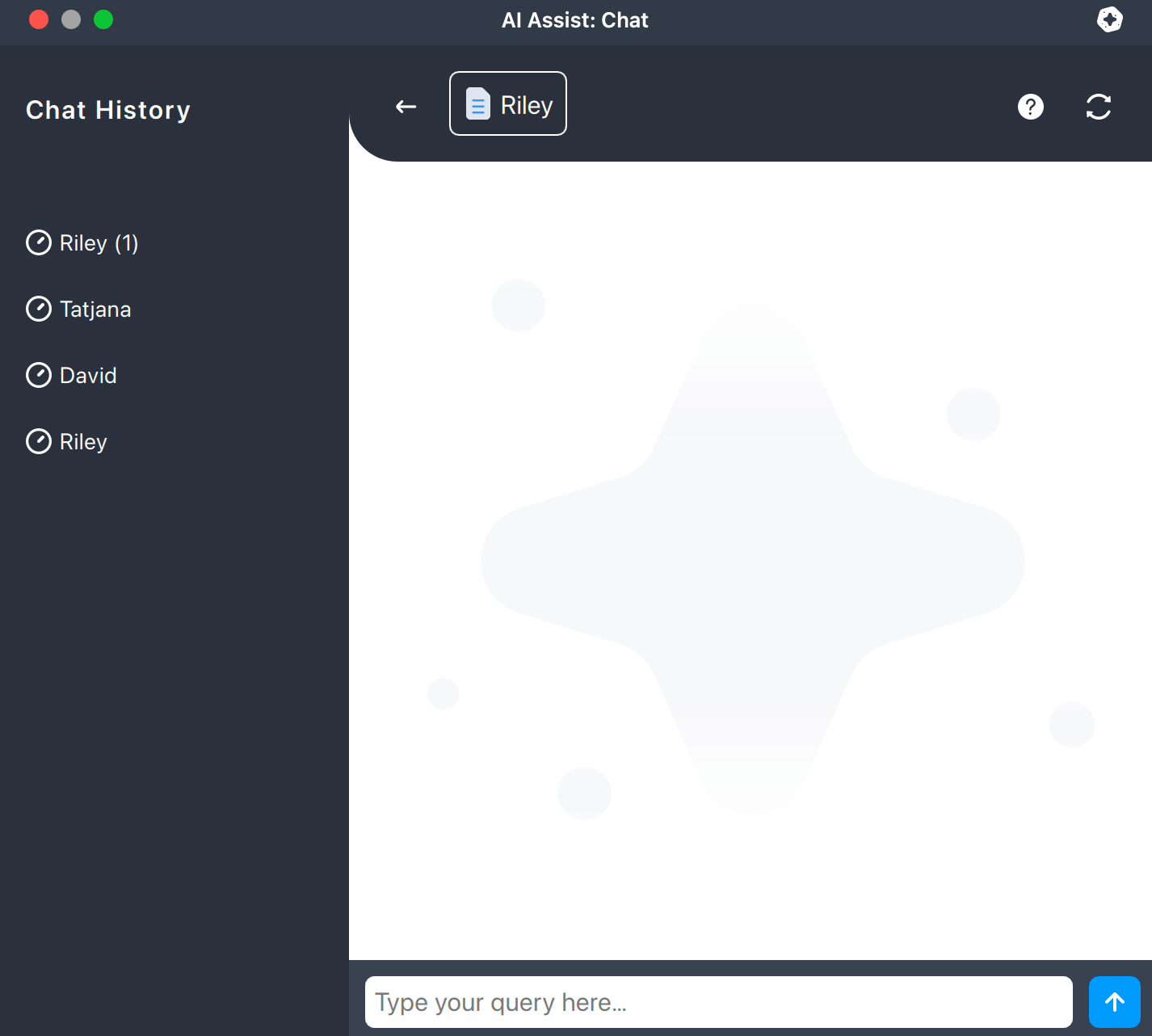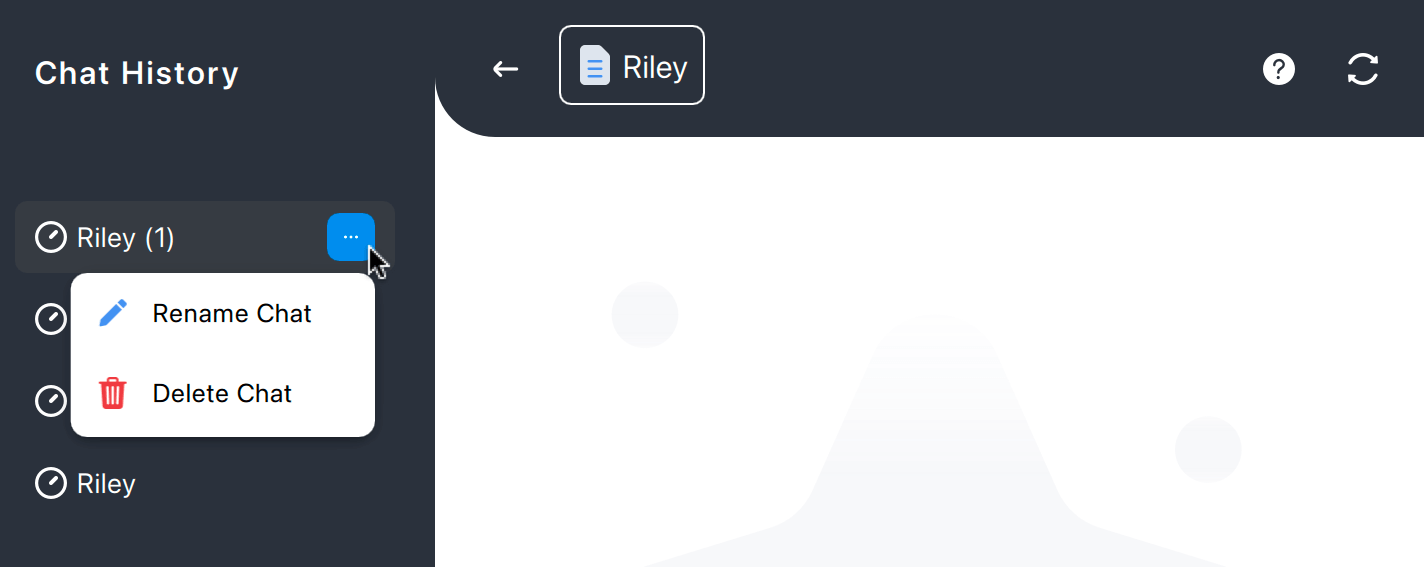What is AI Assist’s chat function?
AI Assist’s chat opens up a world of possibilities for you to interact with PDF or text documents within MAXQDA’s desktop interface. By posing questions and queries about them, you can engage in a dynamic exchange of information. This function unlocks the transformative potential of dialogue in your data analysis, sparking your curiosity and driving more profound insights.
For instance, if engaging with an interview transcript, you may inquire about the topics discussed or seek thematic insights. Similarly, if you are analyzing a peer-reviewed journal article, you may ask the chat to summarize each section and explain the findings or the methods used. These examples are just a glimpse into the wide range of possibilities the chat feature offers, inspiring you to explore and analyze documents in new and exciting ways.
With what kind of documents can I chat?
You can chat with any text or PDF file in your "Document System" within MAXQDA. These files could be anything from interview transcripts and journal articles to news articles, speeches, and corporate reports.

How to chat with a document?
MAXQDA allows you to access AI Assist's chat function using a variety of methods.
- Start chatting via the AI Assist main menu
- Open the document you would like to use the AI Chat with.
- Navigate to the AI Assist main menu and select Chat with This Document.
- Start chatting via the "Document Browser" toolbar
- Open the document you would like to use the AI Chat with.
- Hover your mouse over the
 AI Assist icon in the "Document Browser" toolbar and choose Chat with This Document.
AI Assist icon in the "Document Browser" toolbar and choose Chat with This Document.


Once the chat opens, you can type your query, and AI Assist will respond promptly, usually within seconds.
Navigating AI Chat's text references
You will often find that AI Assist provides answers with references to the original text, indicating paragraph numbers for text documents and page numbers for PDFs.
These references enable you to review the original document, delving deeper into the content and scrutinizing the source material in conjunction with the generated response.
Click on a reference, and voilà! The corresponding text passage is highlighted in the "Document Browser," ready for analysis.
Managing chat history
The chat history feature in MAXQDA is designed to help you manage and revisit your previous conversations, whether you are chatting with a document or coded segments. To access your chat history, click the chat history icon, resembling a clock, located next to the document's name. When clicked, it will open the chat history list, displaying all your previous chats.
When you open the Chat History during an ongoing conversation and click on a previous chat, the current conversation will automatically be deactivated. It will then be moved into the Chat History log.

MAXQDA automatically saves a copy of a chat as soon as it is closed, including date and author's name. Chats are saved locally on your computer within your MAXQDA project file.
If you do not wish to keep a copy of your chat, you can delete it from the chat history list manually.
Chat names
Saved chats are automatically named based on their content, such as "Riley." If a chat with the same name already exists, a bracket number is used to differentiate the two chats, like "Riley (1)." If a chat name is too long, you may hover over the entry for a tooltip to appear with its full name.
Rename and delete chats

When you hover over a chat in the chat history list, a hover effect will display a context button. Clicking this button will bring up a dropdown menu with two options:
- Delete Chat: Permanently remove the chat from your project file.
- Rename Chat: Edit a chat's name for easier identification.
Saving AI Assist responses
If you wish to copy a response into a memo or a report, you can simply copy and paste it. To copy an entire response, click the copy icon ![]() below the chatbot’s response. To copy only a specific section, select it and then click on the Copy button that pops up while selecting the text (or use Ctrl+C on Windows and cmd+C on Mac).
below the chatbot’s response. To copy only a specific section, select it and then click on the Copy button that pops up while selecting the text (or use Ctrl+C on Windows and cmd+C on Mac).
Then, you can paste the response in the location of your choice either by right-clicking to access the context menu or using the Ctrl+V shortcut on Windows and cmd+V shortcut on Mac.
Best practices to maximize your chat experience
- Reset the chat history before starting a new topic to ensure that previous conversations do not influence subsequent responses. For instance, if you have discussed a company’s business strategy and then wish to inquire about marketing techniques, it is best to delete the chat history first.
- When appropriate, specify the desired output format or response style, e.g., "bullet points," "two sentences," or "academic style."
- Break down complex tasks into a sequence of simple prompts.
- Use formulations that are as concise and precise as possible.
- It is not necessary to be polite—but it does not hurt either.
- For tasks that do not require AI, use other MAXQDA functions, e.g., the "Text Search" to search for words.
Frequently asked questions
Are AI Assist's chat responses accurate?
While the chat primarily delivers accurate results across scenarios, verifying the responses’ accuracy is essential, including checking the provided references. Your diligence ensures that you can confidently rely on the information provided by the chat.
Are the references to the original text correct?
As a rule, the references point to relevant text passages. In some cases, references are made to adjacent or inappropriate text passages. Therefore, it is crucial to check the references, especially in the case of very long texts with many short paragraphs.
Which languages does the chat support?
AI Assist’s AI Chat supports almost all widely spoken languages. The language of the text being analyzed may differ from the language you’re communicating with the chat. For example, you can ask questions in German when chatting with a document written in English. Typically, responses are provided in the language of your query. However, the chatbot may respond in English for languages less commonly used online.
Which document types can I chat with in MAXQDA?
You can chat with text documents and PDFs. However, please note that only text data is considered in PDFs. Images or image-based text are not included.
How large can the documents be?
The chat supports documents up to 100,000 characters long, approximately 25 pages, depending on formatting. However, character limits may be lower for languages such as Japanese due to shorter text lengths. MAXQDA will notify you if your selected document exceeds the chat’s capacity.
Does the chat always give the same answer to the same question?
No. The answers may vary slightly, especially if the chat history has progressed. Even if you restart the chat and ask the same first question as in your last chat, the content of both answers will generally be similar, but the wording may differ.
- If you analyze texts with critical content (violence, hate speech, bullying, etc.), AI Assist may refuse to answer.
- AI Assist may respond that the request doesn’t match a document’s content. If this occurs, try rephrasing your prompt.
- The time it takes to receive a response may vary depending on the number of requests in the queue.
